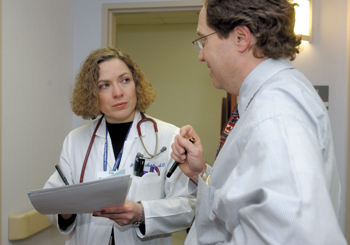
Dr. Barbara Murphy consults with Dr. Brian Burkey, a surgeon, about a patient. Murphy and radiation oncologist Dr. Anthony Cmelak hold clinic with the surgeons, increasing options for patients. (photo by Dana Johnson)
Multi-disciplinary clinic treats hundreds each year
Each year, about 300 people come to Vanderbilt University Medical Center to be treated for head and neck cancer, making it one of the busiest centers in the nation for that specialty.
And because of a cooperative team of cancer care specialists between the Vanderbilt-Ingram Cancer Center and the Vanderbilt Bill Wilkerson Center for Otolaryngology and Communication Sciences, many patients here have unique options—first among them the opportunity to see, in the same visit, a surgeon, a medical oncologist and a radiation oncologist, in exam rooms just a few steps apart.
“Having a dedicated medical oncologist and radiation oncologist is what makes Vanderbilt truly unique in the treatment of head and neck cancers,” says Dr. Stephen Bayles, assistant professor of Otolaryngology, a department within the Vanderbilt Bill Wilkerson Center for Otolaryngology and Communication Sciences, and one of three head and neck cancer surgeons on faculty who see patients in the clinic. “It helps expand our treatment options for any given patient. We had seen dramatic and remarkable successes that we wouldn’t have had without the team.”
The clinic itself is an outgrowth of success, says Dr. Barbara Murphy, associate professor of Medicine in Hematology/Oncology in the Vanderbilt-Ingram Cancer Center. “There aren’t many medical centers in the country with significant numbers of head and neck cancer patients, so there is a lack of expertise and no coordinated effort.”
The standard of care for these patients has changed radically in the past five years, Murphy says. Patients seen in Vanderbilt’s multi-modality clinic see the effects firsthand—if surgeons rule out an operation, patients can within minutes go over alternative treatments with Murphy or Dr. Anthony Cmelak, assistant professor of Radiation and Radiological Sciences in Radiation Oncology.
The large numbers of patients also facilitate clinical research trials, which puts the clinicians on the cutting edge of treatment and allows them to offer patients the latest methods. Studies include:
•A function preservation trial being conducted through the Eastern Cooperative Oncology Group with Cmelak as the principal investigator. The study was based on a successful pilot trial conducted through the Vanderiblt-Ingram Cancer Center. The trial is novel because it incorporates swallowing and voice assessments to evaluate the impact of treatment on function and quality of life.
•A study to assess the nutritional deficits in head and neck cancer patients who have completed therapy. Murphy is working with Janet Friedman, Ph.D., R.D., research assistant professor of Medicine in the Vanderbilt Center for Human Nutrition, on the project, which engages the resources of the Clinical Nutrition Research Unit. Many of these patients have lost the function of their salivary glands or have other deficits that cause trouble swallowing. Patients are contacted by phone to provide a 24-hour diet recall, and state-of-the-art software analyzes their nutrient intake to assess diet deficiencies.
In addition to institutional studies, VICC participates in important national studies that help change the standard of care for patients with this tumor. Examples are:
•A function preservation study, Study 9111, looked at laryngeal cancers, which often require the removal of the voice box, when surgery was an option. It compared radiation treatment alone to a combination of radiation and chemotherapy. The combination therapy improved outcomes by 33 percent, meaning more people avoided surgery and got to keep their voice.
•Trial E1392 looked at laryngeal cancer when the disease was too far advanced to warrant a lengthy and aggressive operation. It also compared radiation alone to radiation and chemotherapy, and the cure rate went from 20 percent to 38 percent.
The benefit of cancer treatment advances, Murphy says, is that “we cure many of them, even advanced tumors.” But, she adds, “because patients are benefiting from longer survival and functional preservation, they have to learn how to deal with the side effects.”
To help patients and clinicians not only learn more about side effects, but to help do something about them, Murphy has established a pain and symptom management clinic. In April, nurse practitioner Pam Bolen will begin seeing patients full-time.













